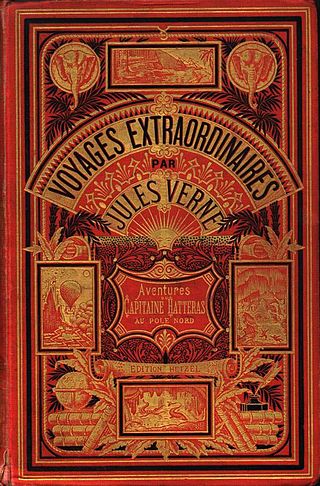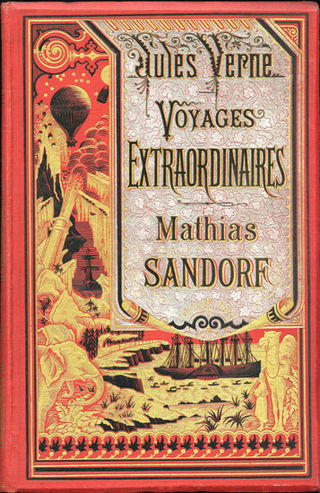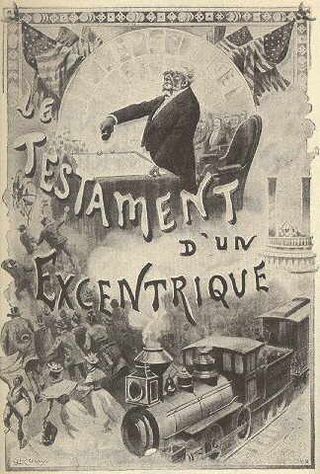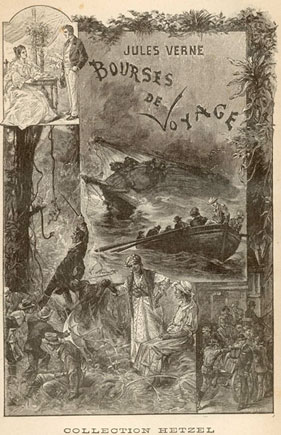
Jules Gabriel Verne was a French novelist, poet, and playwright. His collaboration with the publisher Pierre-Jules Hetzel led to the creation of the Voyages extraordinaires, a series of bestselling adventure novels including Journey to the Center of the Earth (1864), Twenty Thousand Leagues Under the Seas (1870), and Around the World in Eighty Days (1872). His novels, always well documented, are generally set in the second half of the 19th century, taking into account the technological advances of the time.

From the Earth to the Moon: A Direct Route in 97 Hours, 20 Minutes is an 1865 novel by Jules Verne. It tells the story of the Baltimore Gun Club, a post-American Civil War society of weapons enthusiasts, and their attempts to build an enormous Columbiad space gun and launch three people — the Gun Club's president, his Philadelphian armor-making rival, and a French poet — in a projectile with the goal of a Moon landing. Five years later, Verne wrote a sequel called Around the Moon.

The Mysterious Island is a novel by Jules Verne, published in 1875. The first edition, published by Hetzel, contains illustrations by Jules Férat. The novel is a crossover sequel to Verne's famous Twenty Thousand Leagues Under the Seas (1870) and In Search of the Castaways (1867–68), though its themes are vastly different from those books. An early draft of the novel, rejected by Verne's publisher and wholly reconceived before publication, was titled Shipwrecked Family: Marooned with Uncle Robinson, indicating the influence of the novels Robinson Crusoe and The Swiss Family Robinson. Verne developed a similar theme in his novel, Godfrey Morgan.

The Voyages extraordinaires is a collection or sequence of novels and short stories by the French writer Jules Verne.

Mathias Sandorf is an 1885 adventure book by the French writer Jules Verne first serialized in Le Temps in 1885. It employs many of the devices that had served well in his earlier novels: islands, cryptograms, surprise revelations of identity, technically advanced hardware and a solitary figure bent on revenge. Verne planned Mathias Sandorf as the Mediterranean adventure of his series of novels called Voyages extraordinaires. He dedicated the novel to the memory of Alexandre Dumas.

Off on a Comet is an 1877 science fiction novel by French writer Jules Verne. It recounts the journey of several people carried away by a comet contacting the Earth. The comet passes by various bodies in the Solar System before returning the travelers to the Earth.

Texar's Revenge, or, North Against South is the full title of the English translation of the novel written by the French science-fiction author Jules Verne, and centers on the story of James Burbank, an antislavery northerner living near Jacksonville, Florida, and Texar, a pro-slavery southerner who holds a vendetta against Burbank. Originally published in France in 1887, the book received a tepid reaction upon its release in the United States, partly because of Verne's inexpertise regarding some details of the American Civil War, and has since fallen into obscurity compared to many of Verne's other works.

Les Indes noires is a novel by the French writer Jules Verne, serialized in Le Temps in March and April 1877 and published immediately afterward by Pierre-Jules Hetzel. The first UK edition was published in October 1877 by Sampson Low, Marston, Searle and Rivington as The Child of the Cavern, or Strange Doings Underground. Other English titles for the novel include Black Diamonds and The Underground City.

Two Years' Vacation is an adventure novel by Jules Verne, published in 1888. The story tells of the fortunes of a group of schoolboys stranded on a deserted island in the South Pacific, and of their struggles to overcome adversity. In his preface to the book, Verne explains that his goals were to create a Robinson Crusoe-like environment for children, and to show the world what the intelligence and bravery of a child were capable of when put to the test.

Dr. Ox's Experiment is a humorous science fiction short story by the French writer Jules Verne, published in 1872. It describes an experiment by one Dr. Ox, and is inspired by the real or alleged effects of oxygen on living things.

The Begum's Fortune, also published as The Begum's Millions, is an 1879 novel by Jules Verne, with some utopian elements and other elements that seem clearly dystopian. It is noteworthy as the first published book in which Verne was cautionary, and somewhat pessimistic about the development of science and technology.

Facing the Flag or For the Flag is an 1896 patriotic novel by Jules Verne. The book is part of the Voyages extraordinaires series.

Propeller Island is a science fiction novel by French author Jules Verne (1828–1905). It was first published in 1895 as part of the Voyages Extraordinaires. It relates the adventures of a French string quartet in Milliard City, a city on a massive ship in the Pacific Ocean, inhabited entirely by millionaires.

Invasion of the Sea is an adventure novel written by Jules Verne. It was published in 1905, the last to be published in the author's lifetime, and describes the exploits of Berber nomads and European travelers in Saharan Africa. The European characters arrive to study the feasibility of flooding a low-lying region of the Sahara desert to create an inland sea and open up the interior of Northern Africa to trade. In the end, however, the protagonists' pride in humanity's potential to control and reshape the world is humbled by a cataclysmic earthquake which results in the natural formation of just such a sea.

The Chase of the Golden Meteor is a novel by Jules Verne. It was one of the last novels written by the prolific French hard science fiction pioneer. The book, however, is seen as less an early example of hard science fiction than a social satire lampooning greed, monomania and vanity. Verne first wrote La Chasse au météore in 1901 and then rewrote it before his death, but it was only published in 1908, three years after the author's death, one of seven such posthumous novels.

The Will of an Eccentric is a 1900 adventure novel written by Jules Verne based on the Game of the Goose.

Captain Antifer is an adventure novel written by Jules Verne. The novel tells of a treasure hunt, where the clues – arriving in bits and pieces – lead the seaman Pierre Antife of Saint-Malo and various others of diverse nationalities and backgrounds on a complicated route – from Tunisia to the Persian Gulf, the Gulf of Guinea, and then to Edinburgh, Spitzbergen, and finally to the Mediterranean off Sicily.

Travel Scholarships is a 1903 adventure novel by Jules Verne.

"A Drama in the Air" is an adventure short story by Jules Verne. The story was first published in August 1851 under the title "Science for families. A Voyage in a Balloon" in Musée des familles with five illustrations by Alexandre de Bar. In 1874, with six illustrations by Émile-Antoine Bayard, it was included in Doctor Ox, the only collection of Jules Verne's short stories published during Verne's lifetime. An English translation by Anne T. Wilbur, published in May 1852 in Sartain's Union Magazine of Literature, marked the first time a work by Jules Verne was translated into the English language.

Jules Verne (1828–1905) was a French novelist, poet, and playwright. Most famous for his novel sequence, the Voyages Extraordinaires, Verne also wrote assorted short stories, plays, miscellaneous novels, essays, and poetry. His works are notable for their profound influence on science fiction and on surrealism, their innovative use of modernist literary techniques such as self-reflexivity, and their complex combination of positivist and romantic ideologies.




















